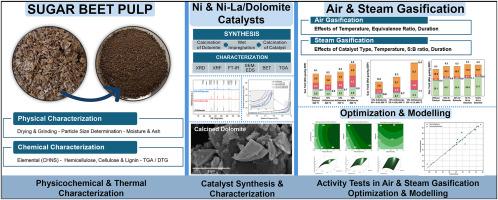Valorization of sugar beet pulp via gasification for hydrogen-rich syngas production: Experimental study, optimization, and modeling
IF 5.8
2区 生物学
Q1 AGRICULTURAL ENGINEERING
引用次数: 0
Abstract
Hydrogen-rich syngas production through gasification of sugar beet pulp (SBP), a byproduct of sugar processing factories, was investigated in the presence of dolomite-supported Ni and Ni-La catalysts. For this purpose, catalysts with varying metal loadings (10, 20% Ni and 10–1, 10-3% Ni-La by wt%) were synthesized via the impregnation method and characterized by X-ray Diffraction (XRD), X-ray Fluorescence (XRF), Fourier Transform Infrared Spectroscopy (FT-IR), Scanning Electron Microscopy - Energy Dispersive X-ray Spectroscopy (SEM-EDS), Brunauer–Emmett–Teller (BET) surface area analysis, and Thermogravimetric Analysis (TGA). Gasification experiments with 10% Ni/Dolomite catalyst examined the effects of gasification temperature (600, 700, and 800 °C), and equivalence ratio (ER = 0.03, 0.09, 0.15), where the highest hydrogen concentration of 23.1 mol% (2.2 mol H2/kg SBP) was achieved at 700 °C, 0.03 ER. In the subsequent steam gasification experiments, the effects of catalyst type, steam-to-biomass (S:B) ratio, reaction temperature, and gasification duration were studied. Experimental highest hydrogen concentration (61.6%) and syngas calorific value (7535 kJ/m3) were achieved with the 10-3% Ni-La/Dolomite catalyst. Optimization studies were performed using full factorial design, analysis of variance (ANOVA), and Response Surface Methodology (RSM). Modeling of the gasification process employed Artificial Neural Networks (ANN) using Keras model in Python. Optimum gasification conditions were identified as 711.20 °C, 14.58 min, and S:B = 4.99, yielding 57.7 mol% hydrogen for 10% Ni/Dolomite catalyst. This study demonstrates that optimized steam gasification effectively valorizes sugar beet pulp by achieving high hydrogen yields and concentrations.

通过气化生产富氢合成气的甜菜浆的增值:实验研究,优化和建模
研究了在白云石负载Ni和Ni- la催化剂的作用下,糖厂副产物甜菜浆(SBP)气化制富氢合成气的工艺。为此,采用浸渍法制备了不同金属负荷量(10%、20% Ni和10%、10%、3% Ni- la)的催化剂,并用x射线衍射(XRD)、x射线荧光(XRF)、傅里叶变换红外光谱(FT-IR)、扫描电子显微镜-能量色散x射线能谱(SEM-EDS)、布鲁纳尔-埃米特-泰勒(BET)表面积分析和热重分析(TGA)对催化剂进行了表征。10% Ni/白云石催化剂气化实验考察了气化温度(600、700和800℃)和等效比(ER = 0.03、0.09和0.15)的影响,其中700℃、0.03 ER时氢气浓度最高,达到23.1 mol% (2.2 mol H2/kg SBP)。在后续的蒸汽气化实验中,研究了催化剂类型、蒸汽与生物质(S:B)比、反应温度和气化时间对气化效果的影响。当Ni-La/白云石催化剂用量为10-3%时,氢气浓度达到61.6%,合成气热值达到7535 kJ/m3。优化研究采用全因子设计、方差分析(ANOVA)和响应面法(RSM)进行。气化过程的建模采用人工神经网络(ANN),使用Python中的Keras模型。在10% Ni/白云石催化剂条件下,最佳气化条件为711.20℃,14.58 min, S:B = 4.99,产氢率为57.7 mol%。该研究表明,优化的蒸汽气化通过实现高氢气产量和浓度有效地提高甜菜浆的价格。
本文章由计算机程序翻译,如有差异,请以英文原文为准。
求助全文
约1分钟内获得全文
求助全文
来源期刊

Biomass & Bioenergy
工程技术-能源与燃料
CiteScore
11.50
自引率
3.30%
发文量
258
审稿时长
60 days
期刊介绍:
Biomass & Bioenergy is an international journal publishing original research papers and short communications, review articles and case studies on biological resources, chemical and biological processes, and biomass products for new renewable sources of energy and materials.
The scope of the journal extends to the environmental, management and economic aspects of biomass and bioenergy.
Key areas covered by the journal:
• Biomass: sources, energy crop production processes, genetic improvements, composition. Please note that research on these biomass subjects must be linked directly to bioenergy generation.
• Biological Residues: residues/rests from agricultural production, forestry and plantations (palm, sugar etc), processing industries, and municipal sources (MSW). Papers on the use of biomass residues through innovative processes/technological novelty and/or consideration of feedstock/system sustainability (or unsustainability) are welcomed. However waste treatment processes and pollution control or mitigation which are only tangentially related to bioenergy are not in the scope of the journal, as they are more suited to publications in the environmental arena. Papers that describe conventional waste streams (ie well described in existing literature) that do not empirically address ''new'' added value from the process are not suitable for submission to the journal.
• Bioenergy Processes: fermentations, thermochemical conversions, liquid and gaseous fuels, and petrochemical substitutes
• Bioenergy Utilization: direct combustion, gasification, electricity production, chemical processes, and by-product remediation
• Biomass and the Environment: carbon cycle, the net energy efficiency of bioenergy systems, assessment of sustainability, and biodiversity issues.
 求助内容:
求助内容: 应助结果提醒方式:
应助结果提醒方式:


